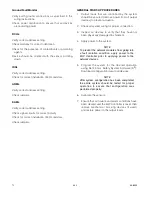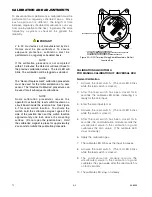
7.1
95-8533
5-1
Section 5
Maintenance
ROUTINE MAINTENANCE
To ensure reliable protection, it is important to check
and calibrate the system on a regularly scheduled
basis. The frequency of checks is determined by the
requirements of the particular installation.
BATTERIES
Batteries
must
be replaced every 48 months, or
sooner if required by local codes.
IMPORTANT!
Only sealed batteries are to be used.
MANUAL CHECK OF OUTPUT DEVICES
It is important that response devices be checked
initially when the system is installed, as well as
periodically during an on-going maintenance
program.
CAUTION!
Be sure to secure all output devices that are
actuated by the system to prevent unwanted
activation of equipment, and remember to place
these output devices back into service when the
checkout is complete.
O-RING MAINTENANCE
wARNING!
The hazardous area must be de-classified prior
to removing a junction box cover with power
applied.
A rubber O-ring is used to ensure that the junction
box cover will seal tightly and provide protection
against water entry. The enclosure should be opened
periodically, and the O-ring inspected for breaks,
cracks and dryness.
To test O-ring: remove it from the enclosure and
stretch it slightly. If cracks are visible, replace it. If it
feels dry, a thin coating of lubricant should be applied.
When re-installing the O-ring, be sure that it is properly
seated in the housing groove. It is imperative that this
O-ring be properly installed and in good condition.
Failure to properly maintain it can allow water to enter
the enclosure and cause premature failure. A coating
of lubricant should also be applied to the threads on
the cover before re-assembling the enclosure. This
will both lubricate the cover threads and help prevent
moisture from entering the enclosure.
CAUTION!
The O-rings should be lubricated with a silicone
free grease. The use of other lubricants is not
recommended, since they can adversely affect
the performance of some sensors. Under no
circumstances should a lubricant or compound
containing silicone be used on systems using
catalytic type combustible gas sensors.
GAS SENSOR MAINTENANCE
All gas sensors must be calibrated on a regular basis.
Calibration should typically be performed every 90
days for catalytic and electrochemical sensors.
Catalytic sensors have a finite lifespan. If a successful
calibration cannot be performed, replace the sensor
and recalibrate following the procedure described in
the “Calibration” section below.
Always compare part
numbers to be sure that the correct replacement
sensor is being used.
CAUTION!
Exposure of the sensor to high concentrations of
combustible gases for extended periods of time
can introduce stress to the sensing element and
seriously affect its performance. After exposure,
recalibration should immediately be performed,
and the sensor should be replaced if necessary.
NOTE
Electrochemical sensors have a finite lifespan. If
a successful calibration cannot be performed,
inspect the hydrophobic filter. If the filter is
plugged, replace it and recalibrate the sensor. If
the filter is in good condition, replace the sensor.
Recalibrate following the procedure described in
the “Calibration” section.
Содержание DET-TRONICS 95-8533
Страница 1: ...Instructions 95 8533 Eagle Quantum Premier Fire and Gas Detection Releasing System 7 1 9 09 95 8533 ...
Страница 128: ...7 1 95 8533 A 4 Figure A 1 System Drawing 007545 001 ...
Страница 129: ...95 8533 A 5 7 1 Figure A 2 System Drawing 007545 001 ...
Страница 131: ...95 8533 7 1 B 2 Figure B 1 Drawing 007546 001 ...
Страница 132: ...95 8533 7 1 B 3 Figure B 2 Drawing 007546 001 ...
Страница 134: ...95 8533 7 1 C 2 Figure C 1 Drawing 007547 001 ...
Страница 141: ...95 8533 7 1 D 7 Figure D1 System Drawing 007545 001 ...
Страница 143: ...APPENDIX E E 1 95 8533 7 1 ...
















































